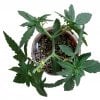After reading the Foliar spray thread I'm tickled. It flies in the face of many ideas we're typically taught about foliar spray like:
- Spraying any type of liquid on your plants under a light will burn them due to light being reflected in the droplets
- Foliar feeding daily is going to kill your plants
- Healthy plants don't need foliar feeding
- Residue will be left on your plant (and lead to 2 or 6)
- You can't foliar spray in flowering or you get mold
- Foliar feeding in flowering affects bud taste
A lot of people were pissed at the suggestion those weren't necessarily true lol.
I'm open to the idea because there's a few things I discovered on my own are myths.
For one:
spraying your plants under lighting does not lead to leaf burn.
I learned about it first in a gardening group when someone explained the intensity of light, even when directly under the sun isn't enough to cause focused heat that would burn leaves. They explained what actually happens is:
- plants need extra water under intense sun / light / temps and will undergo phases of wilting
- There's a certain threshold where if the plants are not watered in time, they will experience damage that won't always be immediately apparent.
- Grower ends up noticing the wilt, waters plants, sees damage and assumes = leaf burn from droplets on leaves.
- In a fully hydrated plant, lights don't burn the leaves.
I've tested this myself and regularly put my plants directly under lighting after spraying them down and there's no burning.
It’s supposedly best to do just as lights come on (leaves are cool from their dark period). But, I’ve personally sprayed water at different times throughout the light cycle without issue.
In the thread, OP linked many studies in favor of foliar feeding
in addition to nutes at watering, resulting in higher yields. I was able to find more papers using Google Scholar.
With misting throughout the day, you can rinse off any residue, just as you would rinse produce before eating.
As for overferting, this seems to be difficult to do with the correct ratio of nutes and plants can regularly (as frequently as daily) take in foliar sprays.
OP foliar sprayed up until week 5 of flower and supplied commercially for medical clients, without it affecting bud taste or acquiring mold. In fact, he made a case for the spray not only reducing the likelihood of mold, but of pests.
TLDR: This my long winded way of saying I'm going to foliar spray in addition to nutes in water and see what happens

When I have clones ready, I'll do one that receives
daily foliar spray until week 5 of flower and the other with only nutes during watering.
2 days in a row I've sprayed it on my veggie garden, houseplants, and ganja...all the girls love it














